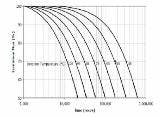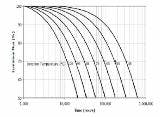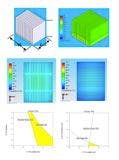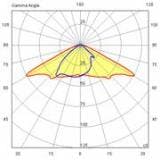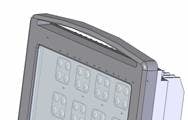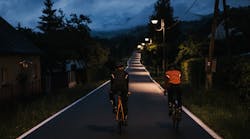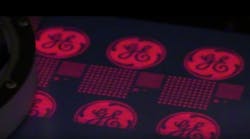On the other hand, LED’s characteristics are obviously different from the traditional lamp, ex. Halogen lamp efficiency raising depends on the heat increasing, but LED is very afraid of heat: worse LED temperature, worse light output. LED light direction is specific, not same as traditional lamp full direction. All of the differences between LED and traditional lamps are shown in Table 1. Since there exists obvious differences, the thermal, optical, power, mechanism and control become very important as one designs LED lighting products.
LED street light design and analysis
An excellent LED lighting product has to consider: thermal, optical, power and mechanism (industry design).
1. Thermal design
As we know, worse LED junction temperature, worse LED life-time. To guarantee 50,000 hours life-time, AOP has designed a street light in which the LED junction temperature is controlled under 75°C and heat sink temperature variation is constrained below 2°C to ensure all of LEDs applied on the street light can reach the same life. AOP has used a DOE method to analyze the effects of the fin pitch, thickness, height of heat sink and found a best solution; see Fig. 2. We found a reasonable heat sink size to reach designed target, LED junction below 75°C and heat sink temperature variation under 2°C.
Table 2. Uniformity
| 96 Watt, 7156 Lm, 5200K | |
|---|---|
| Max. | 29 Lx |
| Avg. | 13 Lx |
| Min. | 4.5 Lx |
| Uniformity (Min./Avg.) | 0.35 |
3. Mechanism and industry design (patent pending)
In AOP’s street light, we also considered the moving and installation convenience; see Figs. 5 and 6. In the power space, we have installed a socket, so the operator can easily install the city cable into the socket and its process is 100% same as traditional lamp installation. By the way, the bow shape design in the front of luminaire can let the operator easily moved. This luminaire is dust- and water-resistant and its rating reaches IP 65.
Table 3. Current of different LEDs
| LED | 1 | 2 | 3 | 4 | 5 | 6 |
| ILED(mA) | 514.0 | 348.0 | 378.0 | 235.0 | 207.0 | 273.0 |
That was due to the LED light module is designed by series and parallel combined circuit; see Fig. 7. So, if each LED drive voltage is not the same, then the LED will get different current even though you used the constant current design. Hence, if one of then LEDs failed, then it will be quickly extended to others, which was due to the other LED passing more current.
Table 4. Current of multi-channel design
| Channel | 1 | 2 | 3 | 4 | 5 | 6 | 7 | 8 |
| ILED (mA) | 301.1 | 300.8 | 298.2 | 301.5 | 302.8 | 298.4 | 297.7 | 298.1 |
Conclusion
AOP’s street light design is combined of thermal, optical, mechanism and power, hence, all of the possible effects on the LED life are considered. That is why we are very confident our street light product. By the way, based on ITRI measurement data, AOP street light luminaire’s efficacy already reaches 72.8 lm/W; its performance almost cannot be found in the world at this time.
